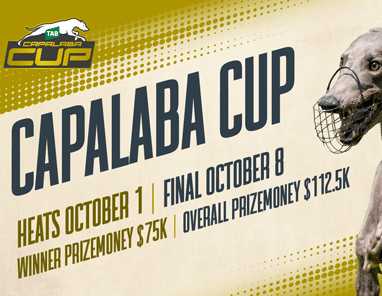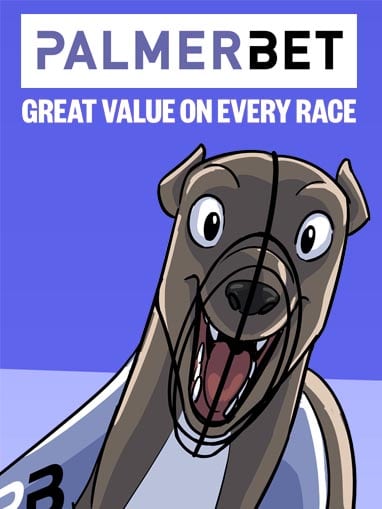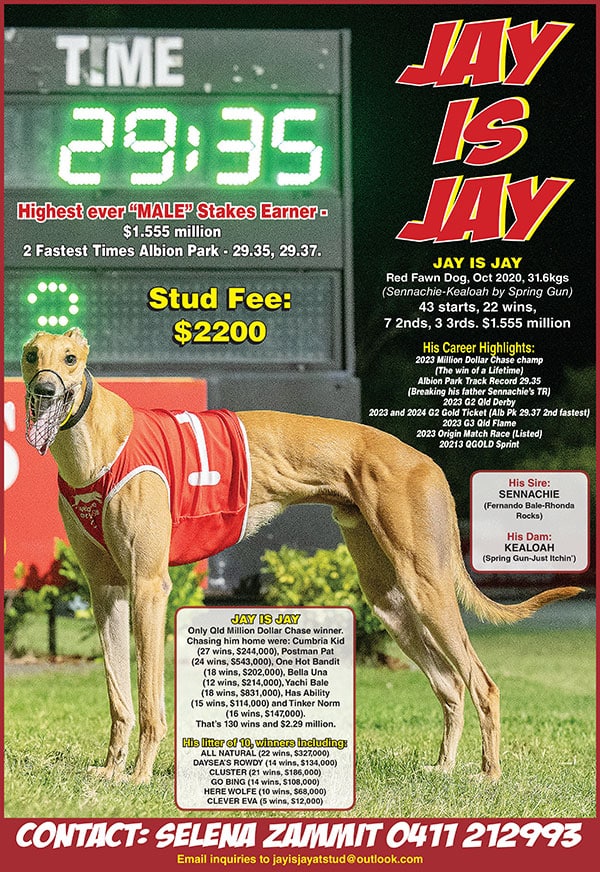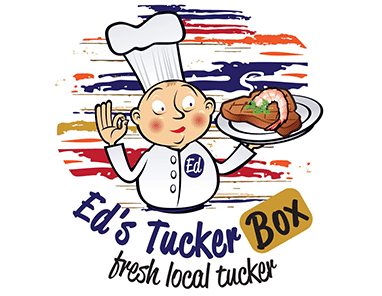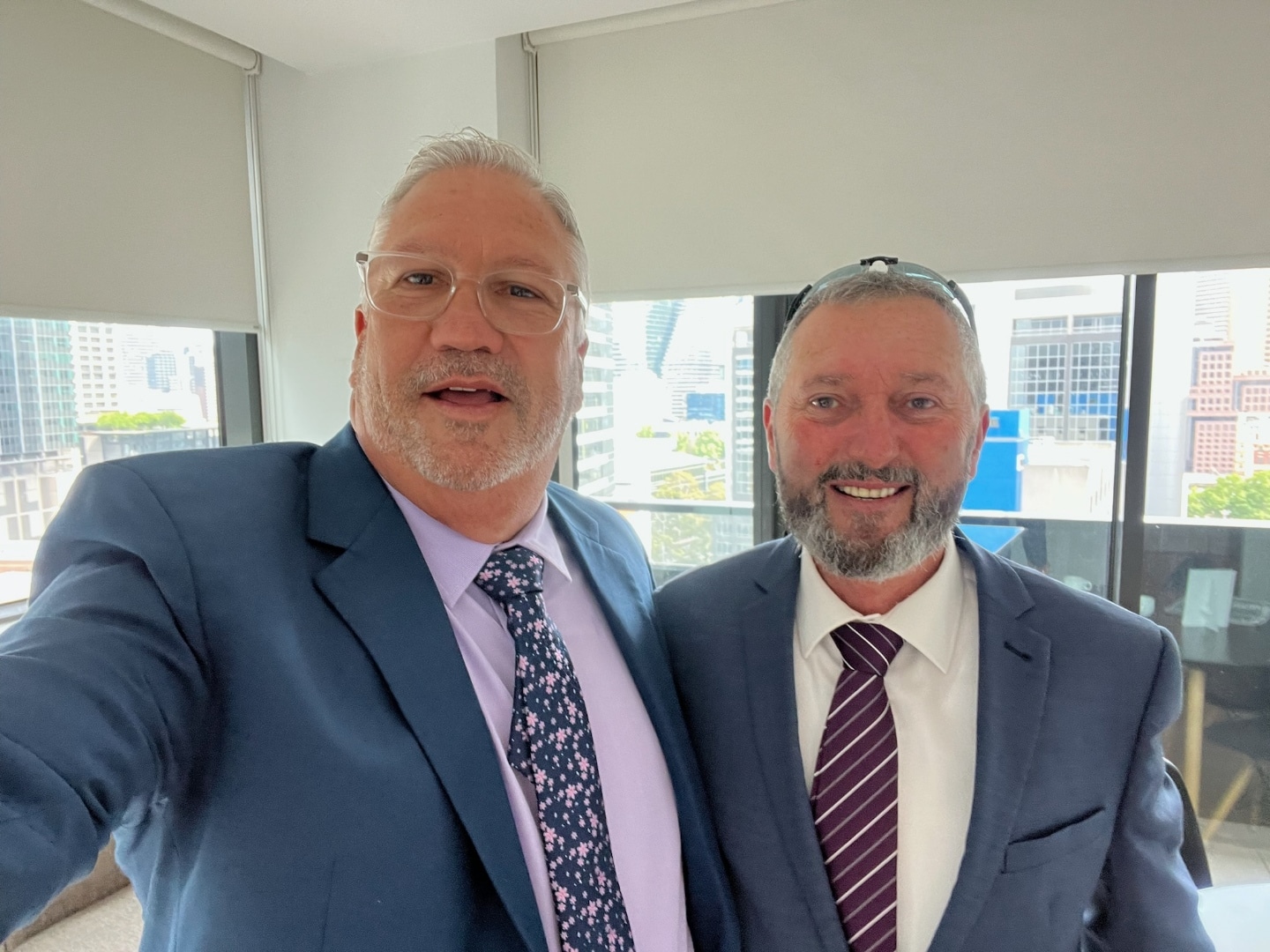
Caption: Brad Mulvihill (left) and good friend and top trainer Mick Zammit
WELL, they say racing is in your blood and, however you look at it, it’s definitely in mine.
My introduction to racing was as a youngster listening to the races with my grandmother and grandfather on Saturdays.
They were avid racegoers and owners of horse winning the TM Ahern Stakes in the mid-1960s with a horse called Albion Rose which was trained by Noel Best.
Then on days they had a win, we would go to Albion Park trots where I always managed to be fascinated by the bookies ring.
My introduction to greyhounds came in the early 1970s when my then swimming coach John Carew had a fawn-and-white bitch called Foxy Loxy which used to race at the Gabba.
Not sure who the trainer was, but I was hooked. I think I was about 12 at the time.
I started listening to the dogs every Thursday night and on occasions during school holidays my mum would take me to the dogs.
The more I followed the dogs, the more interested I became. I also followed the horses especially during the Brisbane, Sydney and Melbourne carnivals.
The good dogs and horses became my heroes.
As the interest grew, I started following and studying pedigrees which I became very familiar with.
During my early days living in suburbia in Graceville, I bred everything from chooks to budgies, guinea pigs and fish … anything that was small and domesticated, I was into it.
My training career started when I was about 18 and I bought a dog from Tony Zammit called Speedy Patch (Kid Scandal-Pitkin’s Pride). He had won only one race over 370m at Lawnton.
During this time I met Jack Dykstra who was Beenleigh’s leading trainer. Jack was so easy to get on with and helpful.
I would go to his place any time. I had to help trial and handle dogs at races. Jack was great at setting dogs to win and loved to punt.
Back then prizemoney wasn’t much, so betting was a big part of how they survived. Jack was patient and thorough with his dogs, getting them checked regularly by Graham Beh.
I remember one of Jack’s biggest plunges was at Beenleigh over 555m with a bitch called Dashing Daphne. She won and won easily being backed from 12-1 to odds-on. In those days there were 10 to 15 bookies at Beenleigh and they would take a bet.
Tony Zammit also was a massive help to me as a young trainer and at this time I met Mick Zammit who has become a lifelong friend.
Speedy Patch went on to win my first ever city race and was one of the best marathon dogs at the time winning over 895m at the Gabba and Beenleigh 802m.
Life has twists and turns, and after a career training dogs full time in the late 1990s, I took a break. It was a tough gig.
We had success even winning five races one night at Albion Park and won feature races with Night Train.
The trouble was we didn’t have the finances to buy quality pups and race dogs.
Over the years, I have kept in touch with Mick. I started my own business as a stock agent and raced horses. You think dogs are tough … horses as ridiculous. I had plenty of wins in the bush which was fun but incredibly expensive.
Mick always suggested I buy a pup or two, which I did.
The transformation in the greyhound industry has been amazing. So, I hooked up with a lifelong friend, Randall Corless, and bought some pups that came from the same damline as Golden Currency – the Kevin Mugavin line and Kev trained a winner at Albion Park on opening night.
As I said previously, pedigrees fascinate me. I once always looked for outcrosses which I learned over time isn’t that successful.
Yes, it does work, but not as well as linebreeding or inbreeding. Every breed of animal I have been involved with has the most success inbreeding.
In my current position as a stock agent, I travelled to the US to visit the home of Brahman cattle, JD Hudgins Ranch. They breed and export the best Brahman genetics all over the world. They follow the line-breeding path, always putting bulls back over female lines that they have bred with.
In the greyhound world it’s especially interesting and easy to research what works and what doesn’t. You need quality to start with. At least a bitch that is city class. I know there will always be exceptions to every rule, but stats don’t lie. Look at the performance of the dams of city winners.
Those better class of dogs cost more. But it’s a short cut to getting into a successful line. Think of the years and money behind your investment.
I have learnt the hard way. It costs the same to have a go and see what happens with second-string dogs.
In racing of any form, stats are huge and don’t lie.
Barcia Bale over Fernando Bale, or vice versa, has a proven track record. I always look for a strong female line with consistent winners of city class or better standard.
I currently have pups out of some of the best race bitches seen in Queensland in recent times and soon I will be chasing my mate Mick for some pups out of Kealoah. They might not all be champions, but I think this quality will give me a chance.
I’ve also taken a punt or two, but based on quality again.
I bought a bitch called Gloria Bale (David Bale-Elfen Bale), a winner at Sandown and The Meadows. My plan is to mate her to Allen Deed.
This is a great cross very similar to the pedigree of Zoha Bale, Yachi Bale and Ailee Bale, a litter that has won more than $1 million.
I have learned the hard way in the past breeding with first season sires in the horses and dogs.
I prefer now to let others experiment and if it works, I will be on the band wagon.
But for now, proven successful bloodlines that click … I’m in.
And, hopefully, Million Dollar Mick can train a champion for me as well.



